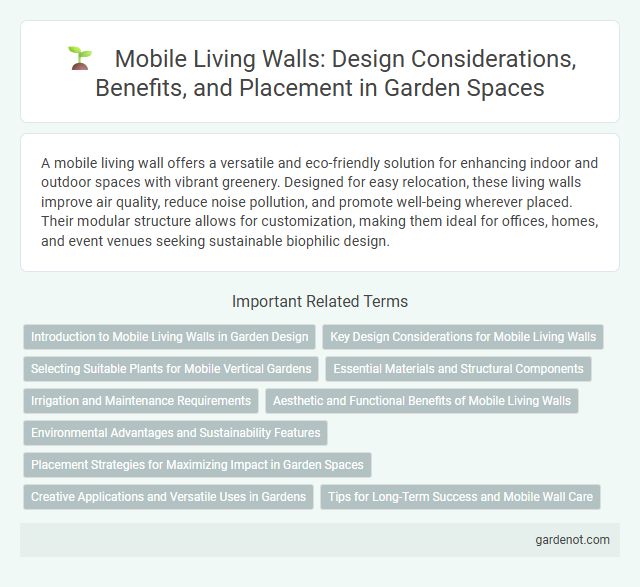A mobile living wall offers a versatile and eco-friendly solution for enhancing indoor and outdoor spaces with vibrant greenery. Designed for easy relocation, these living walls improve air quality, reduce noise pollution, and promote well-being wherever placed. Their modular structure allows for customization, making them ideal for offices, homes, and event venues seeking sustainable biophilic design.
Introduction to Mobile Living Walls in Garden Design
Mobile living walls transform garden design by offering flexible, greenery-filled structures that can be easily relocated to optimize sunlight exposure and spatial aesthetics. These modular panels support diverse plant species, enhancing air quality and biodiversity while providing natural insulation and sound absorption. Ideal for urban gardens and small spaces, mobile living walls merge functionality with eco-friendly innovation, promoting sustainable lifestyle integration.
Key Design Considerations for Mobile Living Walls
Key design considerations for mobile living walls include lightweight, durable frame materials such as aluminum or powder-coated steel to ensure portability and structural integrity. Efficient irrigation systems, often automated drip or hydroponic setups, must be integrated to maintain plant health during movement. Mobility features like lockable caster wheels and modular panel designs facilitate easy transportation and flexible placement in various environments.
Selecting Suitable Plants for Mobile Vertical Gardens
Selecting suitable plants for mobile living walls involves prioritizing species with lightweight root systems and high adaptability to vertical environments. Succulents, ferns, and air plants are ideal because they thrive in limited soil and varying light conditions while maintaining structural integrity during movement. Choosing drought-tolerant and low-maintenance plants ensures longevity and reduces the need for frequent watering and care in mobile vertical gardens.
Essential Materials and Structural Components
Mobile living walls require lightweight aluminum frames for durability and corrosion resistance, paired with modular plant panels made from high-density polyethylene to ensure efficient water retention and root aeration. Integrated drip irrigation systems utilizing flexible tubing distribute water evenly, while non-woven geotextile fabric helps stabilize the growing medium and prevent soil erosion. These essential materials and structural components enable easy mobility and maintenance without compromising plant health or wall stability.
Irrigation and Maintenance Requirements
Mobile living walls require efficient irrigation systems such as drip irrigation or automated misting to ensure consistent moisture levels for plant health. Regular maintenance includes monitoring water distribution, trimming plants to prevent overgrowth, and checking for blockages in irrigation lines to avoid water stress. These measures optimize plant vitality and prolong the lifespan of the mobile living wall structure.
Aesthetic and Functional Benefits of Mobile Living Walls
Mobile living walls enhance indoor environments by combining vibrant plant aesthetics with practical space-saving design, making them ideal for flexible interior layouts. These structures improve air quality, reduce noise pollution, and create natural focal points that adapt to various settings. Their mobility ensures easy reconfiguration, supporting dynamic office spaces and residential areas while promoting well-being and sustainable design.
Environmental Advantages and Sustainability Features
Mobile living walls enhance air quality by filtering pollutants and producing oxygen, significantly improving indoor environmental health. Their modular design allows for easy relocation and adaptability, reducing the need for permanent structural changes and promoting resource efficiency. Integrated irrigation and recycled materials contribute to sustainability by minimizing water usage and reducing waste throughout the product lifecycle.
Placement Strategies for Maximizing Impact in Garden Spaces
Mobile living walls offer versatile placement options that enhance garden aesthetics and functionality by adapting to sunlight patterns and spatial dynamics. Strategic positioning near seating areas or pathways maximizes visual engagement and promotes biodiversity by attracting pollinators. Incorporating mobile living walls in shaded or transitional zones creates microclimates that support diverse plant species and improve air quality.
Creative Applications and Versatile Uses in Gardens
Mobile living walls transform outdoor spaces by offering creative applications such as vertical herb gardens, privacy screens, and dynamic focal points. Their versatility allows gardeners to easily reposition the walls, adapting to seasonal changes or shifting sunlight patterns to optimize plant growth. These portable green installations enhance aesthetics while promoting biodiversity and air quality in garden environments.
Tips for Long-Term Success and Mobile Wall Care
Regular watering and consistent exposure to indirect sunlight ensure the health and vibrancy of a mobile living wall. Use lightweight, nutrient-rich soil to support plant growth while maintaining easy mobility and avoid overwatering to prevent root rot. Periodically check and trim plants to promote airflow and prevent overcrowding, enhancing longevity and aesthetic appeal.
Mobile living wall Infographic

 gardenot.com
gardenot.com